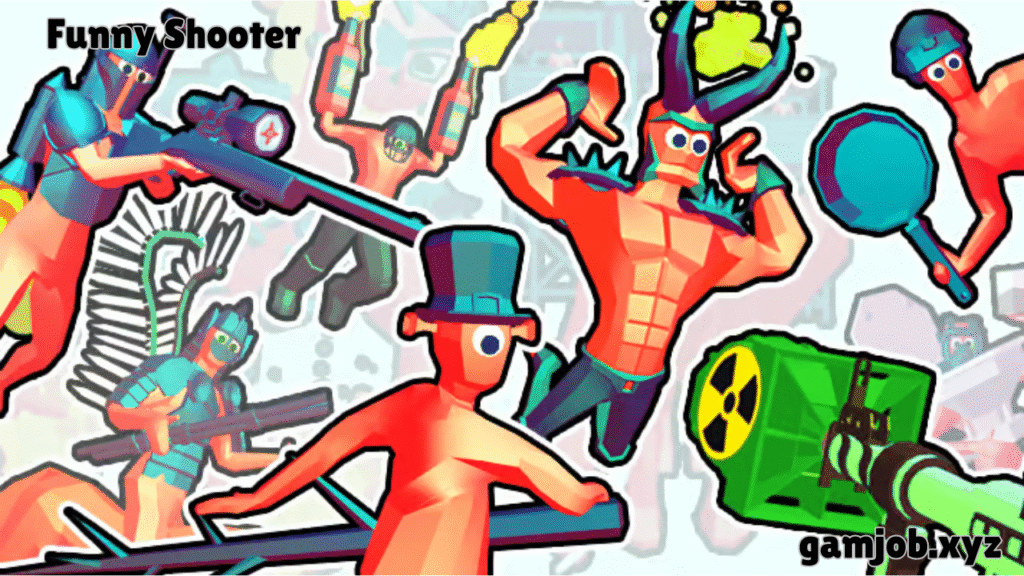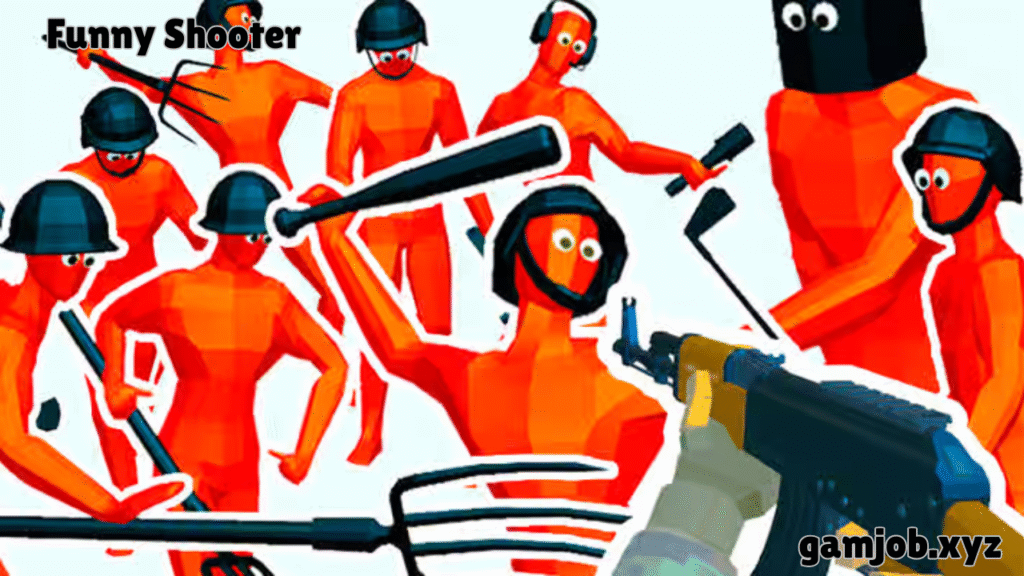Introduction
Funny shooter occupy a unique corner of gaming, where the visceral thrill of gunplay converges with slapstick humor to yield an experience that feels both familiar and delightfully absurd. In these titles, traditional weapon arsenals are traded for rubber chickens, exploding pies, and glitter bombs, transforming every match into a cartoonish free-for-all. Far from being mere gimmicks, the best funny shooters weave comedy into their core design, ensuring that every shot, jump, and explosion elicits genuine laughter as well as competitive satisfaction. Whether players are seeking a lighthearted alternative to military simulations or simply craving an unpredictable playground of physics‐driven mayhem, the funny shooter genre delivers in spades.
Origins of the Genre
Long before high‐fidelity graphics and motion capture, early game designers began experimenting with lighthearted takes on serious mechanics. PC mods occasionally replaced grenade assets with bouncing rubber balls in tactical shooters, hinting at the comedy potential within established frameworks. The true emergence of the funny shooter as its own subgenre gathered momentum in the late 1990s and early 2000s, when indie developers released standalone titles featuring exaggerated physics and whimsical weaponry. These pioneering games emphasized cartoon visuals and outrageous sound effects, demonstrating that humor could coexist with—and even enhance—the core appeal of shooting mechanics. By the time online multiplayer and digital distribution proliferated, funny shooters had earned a dedicated following eager for marketing‐free zaniness.
Core Mechanics with a Twist

At its foundation, a funny shooter retains the familiar triumvirate of targeting, shooting, and movement. From that familiar foundation, however, designers layer on playful subversions. Rather than mapping weapons to realistic ballistics, developers program each “gun” to behave in an idiosyncratic way: one might launch an oversized rubber duck whose quack temporarily stuns opponents, while another fires glitter‐filled capsules that obscure vision. Projectile trajectories arc unpredictably, bounce off walls with comedic thwacks, or home in on targets with cartoonish trails. Recoil animations push player characters spinning into the air, and reload sequences can feature a celebratory dance. This blend of reliable input mapping with whimsical outcomes ensures that strategic decisions—when to fire a sticky bomb, where to place a bounce grenade—remain central, even amidst unrestrained hilarity.
Weapons That Double as Gags
A hallmark of any funny shooter is its weapon roster, often the most eagerly anticipated feature for returning players. Firearms give way to rubber‐based absurdities: the “Pie‐o‐Matic” launches custard pies that splatter in slow motion, temporarily freezing opponents in a comical stance. The “Squeak‐nade” emits a piercing squeak that disorients players, sending their avatars staggering. Upgrades might transform a standard toy gun into a “Mega Gummy Blaster,” spitting out giant gummy bears that roll across the floor, knocking down anyone in their path. Such weapons do more than deliver damage; they introduce emergent scenarios and laughter‐inducing chain reactions. Enthusiasts often debate the relative potency of these gadgets, analyzing which comedic contraption offers the best combination of crowd control and pure entertainment.
Map Design and Environmental Mayhem
Funny shooters often set their zany combat against equally inventive backdrops. Maps range from giant children’s playrooms—complete with oversized blocks and feather‐soft carpets—to wacky theme parks where roller coasters serve as lethal launch pads. Interactive elements abound: players can topple a shelf of bouncing balls, activate a bumper car rink to send opponents careening, or trigger a confetti cannon that blinds the entire arena in a pastel storm. These environmental features double as tactical hazards and comic relief, encouraging players to exploit every bounce pad, slide, and springboard in service of both victory and vaudeville. The result is that no two matches ever unfold the same way, as the map itself becomes a co‐conspirator in the chaos.
Visual Style and Character Animations
Cartoon‐inspired art direction distinguishes funny shooters from their serious counterparts. Bold colors, exaggerated proportions, and fluid, physics‐based animations create a sense of perpetual motion. When a player is hit by a custard pie, their character might freeze in a dazed pose, eyes crossing before wobbling backward. Double kills trigger confetti bursts and disco music stings, rewarding players with both points and panache. Heroes and villains adopt archetypal designs—eccentric scientists, mischievous clowns, pint‐sized tricksters—each equipped with facial expressions that stretch and squash in response to in‐game events. Such visual flourishes reinforce the game’s playful tone, ensuring that even a “defeat” screen arrives with a wink rather than a scowl.
Sound Design and Musical Cues
Equally vital to the funny shooter experience is its bespoke soundscape. Every weapon fires accompanied by a distinct comedic sample: a honk, a boing, or an over-enthusiastic drum roll. Footsteps skitter across the map with cartoon‐like squeaks, while character voice lines quip at perfect comedic timing. Music tracks shift to match the mayhem—lighthearted jazz riffs for casual skirmishes, upbeat techno for frantic final‐circle rushes, and dramatic orchestral swells before an epic boss‐style showdown. Commentary snippets provide context and hype, while each wrestler’s entrance music and voice lines reinforce their unique personalities. Together, these elements immerse players in a cartoon‐like world where laughter is as crucial as victory.
Balancing Humor with Gameplay
Injecting humor into a shooter without undermining its competitive appeal requires finesse. Too many random effects can render matches capricious, while too little comedy reduces the genre to an odd aesthetic veneer. Leading funny shooters employ rigorous playtesting to refine weapon damage, projectile physics, and map spawn points. While a flamboyant banana cannon might flip opponents into the air, its stun duration and trajectory arcs are calibrated so that skilled players can anticipate and evade its effects. Reversals and counters—such as a quick‐time challenge to catch a pie in mid‐air—add a skill component beneath the gags. This careful balancing ensures that laughter and skill coexist, allowing players to develop genuine mastery even as they revel in slapstick.
Progression and Customization
Forging a sense of long‐term engagement, funny shooters integrate robust progression systems. Leveling up grants access to new gag weapons, cosmetic skins—such as polka‐dotted pants or clown noses—and special taunts. Some games include “joke tokens” that unlock rare one‐off weapons, like a disco‐ball mortar or a rocket that plays the “Imperial March” upon launch. Seasonal events introduce themed unlockables—turkey‐shooter crossbows for Thanksgiving or snowball artillery for winter festivals—while daily challenges encourage players to dedicate short bursts of time to earn bonus rewards. By catering to both completionists and casual drop‐in players, these progression frameworks ensure that the comedic mayhem remains fresh far beyond initial novelty.
Mobile and Cross‐Platform Adaptations
While the funny shooter concept originated on PC and consoles, its infectious humor has naturally migrated to mobile platforms. Touchscreen controls map taps and swipes to weapon functions, while gyroscope aiming adds a playful layer of physical engagement. Movers such as “flick to throw a seltzer bottle” translate well to smartphones, making impromptu matches during commutes or lunch breaks a delight. Cross‐platform play further unites communities, allowing players on consoles, PCs, and mobiles to face off in shared lobbies. Cloud saves synchronize customization between devices, ensuring that a home edit of one’s rubber‐duck launcher persists on the go. This fluid ecosystem amplifies the genre’s reach and fosters a global player base united by laughter.
Community Creativity and User‐Generated Content
Funny shooters thrive when they embrace player creativity. Many modern titles offer in‐game editors for custom maps, weapon stats, or sound‐effect loops. Community contests challenge players to design the most absurd weapon concept or the most riotous map hazard, with winning entries sometimes integrated into the official release. Streaming and social media amplify this user‐generated content, as viewers enjoy witnessing homemade contraptions—such as a boomerang‐knife gym or a rocket powered by virtual cats—bring hilarity to life. This co‐creative approach fosters a dynamic ecosystem where developers supply the tools and players supply the imagination, sustaining a feedback loop of comedic innovation.
Monetization with a Smile
Capturing the whimsy of toy‐box artillery while respecting players’ wallets, funny shooters often adopt fair monetization models. Cosmetic microtransactions—irreverent hats, dance emotes, flashy weapon skins—let players express personality without affecting gameplay balance. Battle passes offer progression tracks that deliver gag weapons and silly accessories in exchange for playtime, rather than paywalls. Optional ad views grant token‐sized bonuses—like a handful of rubber bullets or extra joke tokens—without derailing the core experience. This restrained approach preserves the genre’s lighthearted spirit and builds goodwill, ensuring that players never feel pressured into purchases to remain competitive.
Social and Esports Potential
While the apex of competitive play in serious shooters often centers on first‐person skill ceilings and tactical depth, funny shooters carve a friendly niche in grassroots esports. Twitch streamers host weekly “Comical Carnage” tournaments, pitting viewers’ custom characters and loadouts against one another in dinnertime showdowns. Local LAN parties become riotous affairs as friends unleash homemade weapon mods and stage impromptu map designs. Even formal online leagues emerge, armed with casting overlays that highlight critical “LOL moments”—a well‐timed banana blast or a stunning pie‐catch reversal. Though not as regimented as mainstream esports, these scenes thrive on community engagement, laughter, and shared creativity.
Accessibility and Inclusive Design

Funny shooters often lead the way in accessibility. Recognizing that rapid reflexes can be challenging for some players, developers include flexible control schemes, from simplified one‐button firing modes to auto‐aim assist options. Colorblind‐friendly palettes ensure that all projectile and hazard cues remain clear, while scalable UI elements support visually impaired gamers. Audio cues can be toggled or enhanced for hearing‐impaired players, and the forgiving nature of many comedic weapons—where failure often results in a funny animation rather than a frustrating defeat—lowers the barrier to entry. These inclusive features make funny shooters a welcoming playground where skill improves the experience but is never the sole gatekeeper to fun.
Evolution and Future Directions
As technology and player expectations evolve, funny shooters continue to innovate. Advances in procedural generation promise maps that reconfigure in real time, with platforms rising and falling in laughter‐inducing patterns. AI companions might tag along, performing pratfalls on command or delivering snarky commentary. Virtual reality adaptations bring rubber bullets and custard bombs into fully immersive spaces, allowing players to physically duck pies and juggle explosive kittens. Crossovers with popular franchises could introduce licensed comedy weapons and themed arenas—imagine a taco‐launcher for a food cartoon or a tea‐cup grenade for a British comedy event. As technology evolves and player creativity continues to flourish, funny shooters stand poised to expand both their comedic scope and mechanical depth.
Conclusion
Funny shooters remind us that even amid endless spirals of simulated violence, gaming’s greatest power lies in its capacity for joy, surprise, and shared laughter. By pairing core shooter mechanics with outlandish weapons, vibrant arenas, and a generous helping of slapstick, these titles capture a rare synergy: they reward strategic mastery while ensuring every match remains a riot of cartoon chaos. From rubber‐duck grenades to confetti cannons, from banana boomerangs to pie‐toss finishers, the absurd arsenal of the funny shooter genre continues to grow, propelled by developer visions and community creativity alike. In a landscape often dominated by solemn military titles, the comedic carnage of a funny shooter stands out as a testament to gaming’s boundless potential for delight—and a reminder that sometimes, the best way to blow off steam is by blowing up everything in sight, so long as it’s done with a wink, a slapstick flourish, and a side of hearty laughter.